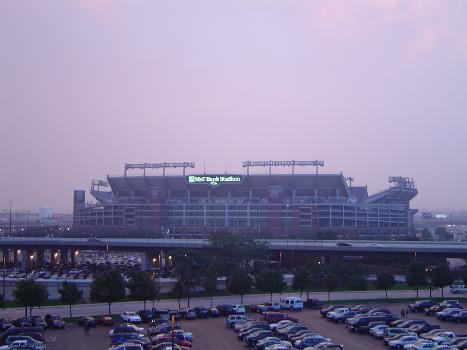General Information
Project Type
| Function / usage: |
Stadium / Arena |
|---|
Location
| Location: |
Baltimore, Maryland, USA |
|---|---|
| Address: | 1101 Russell Street |
| Coordinates: | 39° 16' 41" N 76° 37' 22" W |
Technical Information
Cost
| cost of construction | United States dollar 220 000 000 |
Excerpt from Wikipedia
M&T Bank Stadium is a multi-purpose football stadium located in Baltimore, Maryland. It is the home of the Baltimore Ravens of the National Football League. The stadium is immediately adjacent to Oriole Park at Camden Yards, the home of the Baltimore Orioles. Often referred to as "Ravens Stadium", M&T Bank Stadium officially opened in 1998, and is currently one of the most praised stadiums in the NFL for fan amenities, ease of access, concessions and other facilities.
The stadium was originally known as Ravens Stadium at Camden Yards, until PSINet acquired the naming rights in 1999, naming it PSINet Stadium. It then reverted to Ravens Stadium in 2002 when PSINet filed for bankruptcy. M&T Bank bought the naming rights in 2003 and signed a 15-year, $75 million contract with the Ravens, which was brokered by Team Services, LLC. The naming rights deal for M&T Bank Stadium was renewed for $60M over 10 years in 2014, extending the name through 2027.
History
Ground was broken for the new stadium in mid-1996, shortly after the arrival of the Ravens. The team played its first two years at Memorial Stadium. Although there was some sentiment from Baltimore residents in having the Ravens stay there permanently, it was deemed too old to host an NFL team. (The Orioles moved away from Memorial Stadium after the 1991 season.)
The stadium site was previously the site of the Wm. Knabe & Co. piano factory, which closed during The Great Depression. A sidewalk keyboard mosaic on the southwest corner of the stadium honors the company's legacy.
In 2003, M&T Bank acquired naming rights to the stadium. The bank had recently entered the Baltimore market with its purchase of Allfirst Bank. Two other companies were in the running to be granted naming rights to the stadium; they were reportedly Nextel and CarMax. Following the September 2002 death of Baltimore Colts quarterback Johnny Unitas, public sentiment leaned toward renaming the then-sponsorless stadium after the Baltimore icon. However, the Ravens and the Maryland Stadium Authority held firm in their right to negotiate naming rights fees. In the end, the plaza in front of the main entrance to the Ravens' stadium was named "Unitas Plaza", complete with a bronze statue of the Hall of Famer. The plaza formerly featured large banners, each containing a picture of Unitas in his playing days, flanking the stadium entrance. After 10 years, these were replaced by large metal 19s (Unitas's number) for the 2012 season. In 2014, the Ravens unveiled a new statue of long-time Raven Ray Lewis next to Unitas' statue. The bronze figure depicts Lewis in the final pose of his iconic "squirrel dance", which he would perform before every Ravens home game upon coming on to the field.
Design
The stadium contains five levels, being the lower bowl, club level, 300 suites level, 400 suites level, and the upper bowl. The lower bowl contains 42 rows of seats, split into two sections. The seats below the tunnel entrances are labeled from 1 to 18, while the seats above the tunnels are labeled from 19 to 42, except in sections 123-130, which contain rows 19-35, due to the press box taking up sideline space. On the club level, the rows are labeled from 1 to 13 on the sidelines, and 1 to 17 in the corners where no suites are located. In the upper bowl, the sideline seats are labeled from 1 to 32, while in the upper bowl end zones, the rows range from 1 to 26. Seat widths for the lower and upper bowls of the stadium vary from 19 to 21 inches, due to the curve design of the stadium, while the padded club seats range from 21 to 23 inches respectively.
Playing surface
The stadium originally featured a natural grass surface. However, an artificial surface, Sportexe Momentum Turf, was installed for the 2003 season, which in turn was replaced by a new-generation Sportexe Momentum 51 in 2010. On December 4, 2015, the Ravens announced that in 2016 the team will go back to natural grass playing surface. The listed capacity for M&T Bank Stadium is 71,008.
Tenants
The Ravens are the stadium's primary tenants. On December 7, 2008, an M&T Bank Stadium then-record crowd of 71,438 watched the Baltimore Ravens defeat the Washington Redskins 24-10 on Sunday Night Football, only to be surpassed the next week when the Pittsburgh Steelers defeated the Ravens 13–9 in front of 71,502. On January 15, 2012, a record crowd of 71,547, the largest in Ravens history, was in attendance at the 2011 Divisional Playoff Game in Baltimore against the Houston Texans, which the Ravens won 20–13.
Text imported from Wikipedia article "M&T Bank Stadium" and modified on 23 July 2019 under the CC-BY-SA 3.0 license.
Participants
Relevant Web Sites
- About this
data sheet - Structure-ID
20017776 - Published on:
13/09/2005 - Last updated on:
16/05/2015





